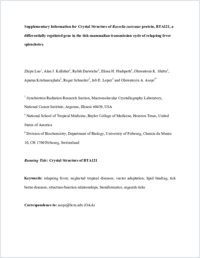Crystal Structure of Borrelia turicatae protein, BTA121, a differentially regulated gene in the tick-mammalian transmission cycle of relapsing fever spirochetes
- Luo, Zhipu Synchrotron Radiation Research Section, Macromolecular Crystallography Laboratory, National Cancer Institute, Argonne, Illinois, USA
- Kelleher, Alan J. National School of Tropical Medicine, Baylor College of Medicine, Houston Texas, USA
- Darwiche, Rabih Division of Biochemistry, Department of Biology, University of Fribourg, Switzerland
- Hudspeth, Elissa M. National School of Tropical Medicine, Baylor College of Medicine, Houston Texas, USA
- Shittu, Oluwatosin K. National School of Tropical Medicine, Baylor College of Medicine, Houston Texas, USA
- Krishnavajhala, Aparna National School of Tropical Medicine, Baylor College of Medicine, Houston Texas, USA
- Schneiter, Roger Division of Biochemistry, Department of Biology, University of Fribourg, Switzerland
- Lopez, Job E. National School of Tropical Medicine, Baylor College of Medicine, Houston Texas, USA
- Asojo, Oluwatoyin A. National School of Tropical Medicine, Baylor College of Medicine, Houston Texas, USA
-
10.11.2017
Published in:
- Scientific Reports. - 2017, vol. 7, no. 1, p. 15310
English
Tick-borne relapsing fever (RF) borreliosis is a neglected disease that is often misdiagnosed. RF species circulating in the United States include Borrelia turicatae, which is transmitted by argasid ticks. Environmental adaptation by RF Borrelia is poorly understood, however our previous studies indicated differential regulation of B. turicatae genes localized on the 150 kb linear megaplasmid during the tick- mammalian transmission cycle, including bta121. This gene is up-regulated by B. turicatae in the tick versus the mammal, and the encoded protein (BTA121) is predicted to be surface localized. The structure of BTA121 was solved by single- wavelength anomalous dispersion (SAD) using selenomethionine-derivative protein. The topology of BTA121 is unique with four helical domains organized into two helical bundles. Due to the sequence similarity of several genes on the megaplasmid, BTA121 can serve as a model for their tertiary structures. BTA121 has large interconnected tunnels and cavities that can accommodate ligands, notably long parallel helices, which have a large hydrophobic central pocket. Preliminary in-vitro studies suggest that BTA121 binds lipids, notably palmitate with a similar order of binding affinity as tablysin-15, a known palmitate-binding protein. The reported data will guide mechanistic studies to determine the role of BTA121 in the tick-mammalian transmission cycle of B. turicatae.
- Faculty
- Faculté des sciences et de médecine
- Department
- Département de Biologie
- Language
-
- English
- Classification
- Biological sciences
- License
-
License undefined
- Identifiers
-
- RERO DOC 306209
- DOI 10.1038/s41598-017-14959-9
- Persistent URL
- https://folia.unifr.ch/unifr/documents/306427
Other files
Statistics
Document views: 99
File downloads:
- pdf: 207
- Supplementary material: 127

